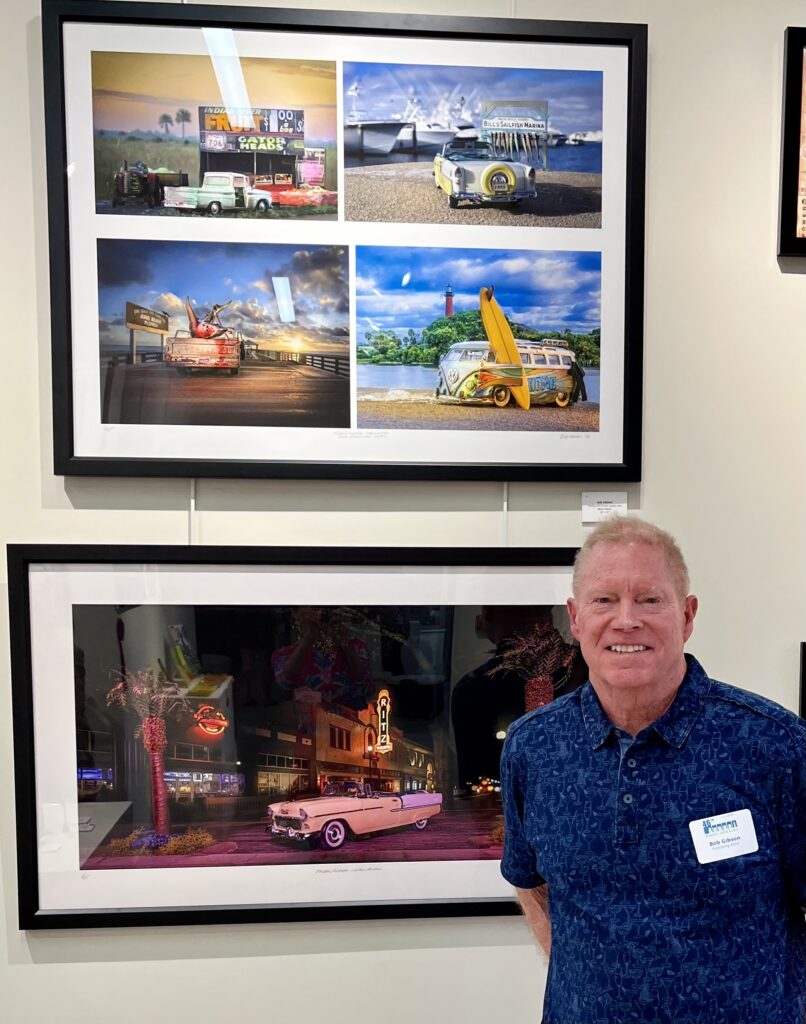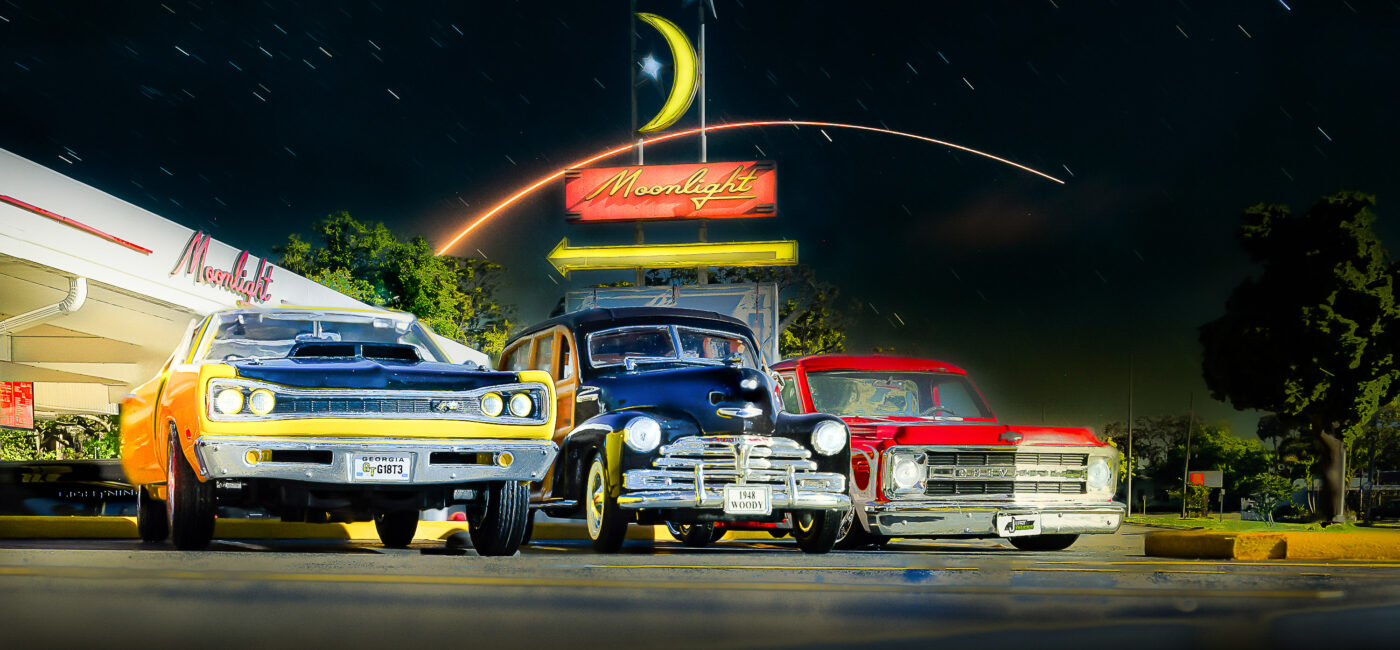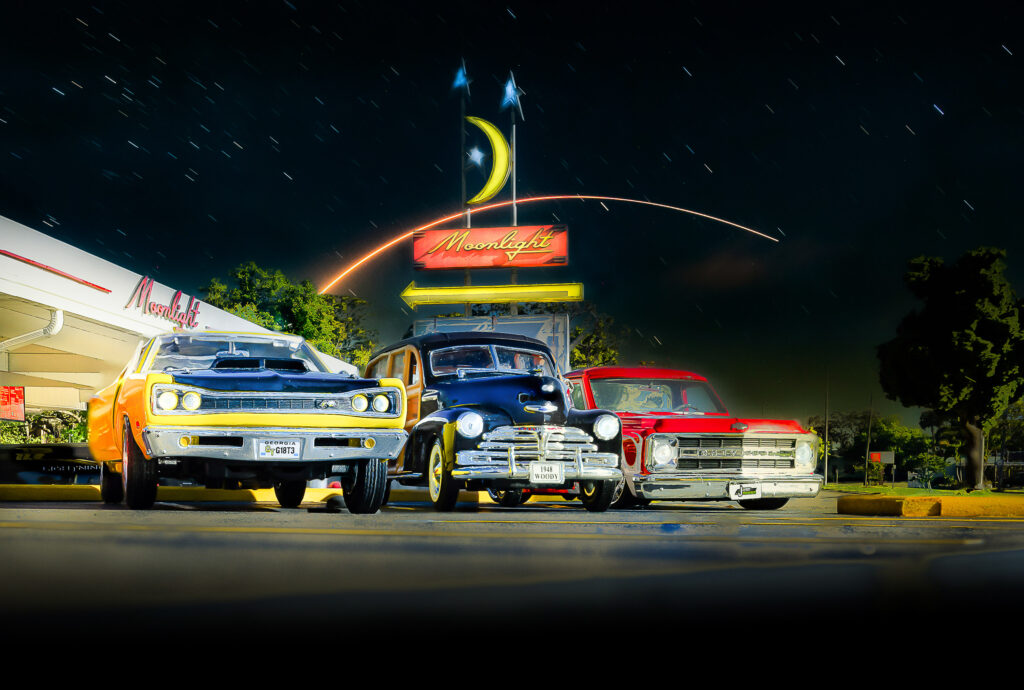
Florida has changed dramatically during my six decades as a resident. I grew up to believe that you are not a real Floridian until you’ve killed a big snake with a garden shovel. I often long for the pristine natural areas and rural country roads abundant in my childhood memories. Now old and full of both time and nostalgia, I decided to hit the backroads to see how much of real Florida still exists.

The trips led me to creating Florida Landscape photos with a nostalgic twist. Each image is shot with a hand-built diorama in the foreground featuring 1960’s era cars and highway billboards. I attempt to give the viewer the feeling I had as a seven year old-looking out the back window of the station wagon during pre-Disney family vacations.
The highway billboards of this decade lured motorists to witness animal shows with oversized reptiles, sea shells and helpings of pecan pie. Roadside stands sold citrus perfume, boiled peanuts, and stuffed alligator heads–in short, anything a first-time tourist would purchase .
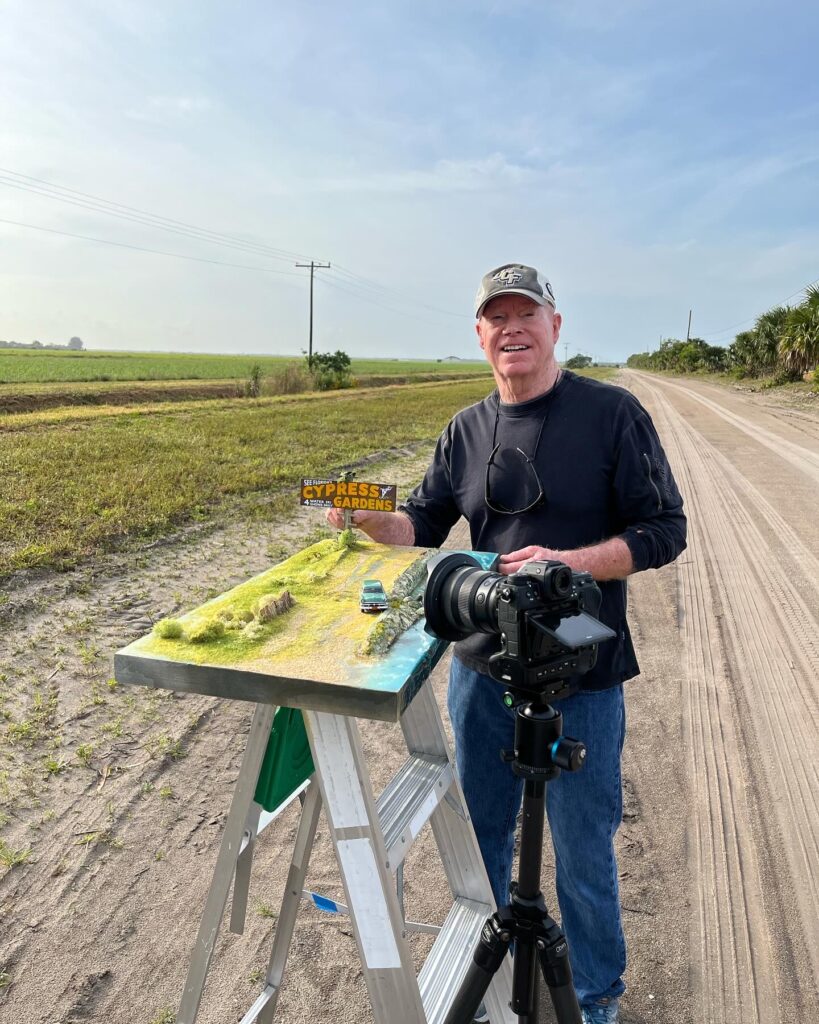
“Finding Florida’ began for me as a nostalgia project and became a history lesson.
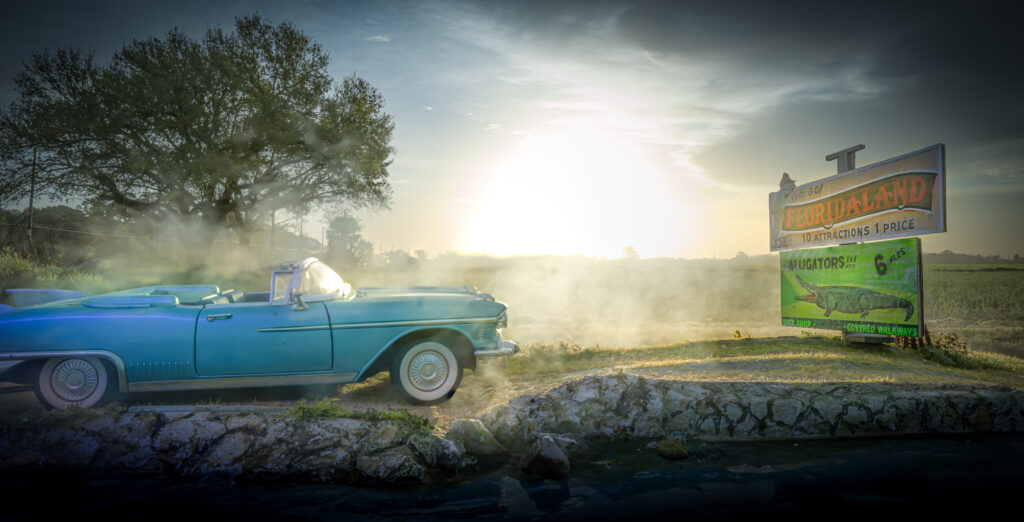
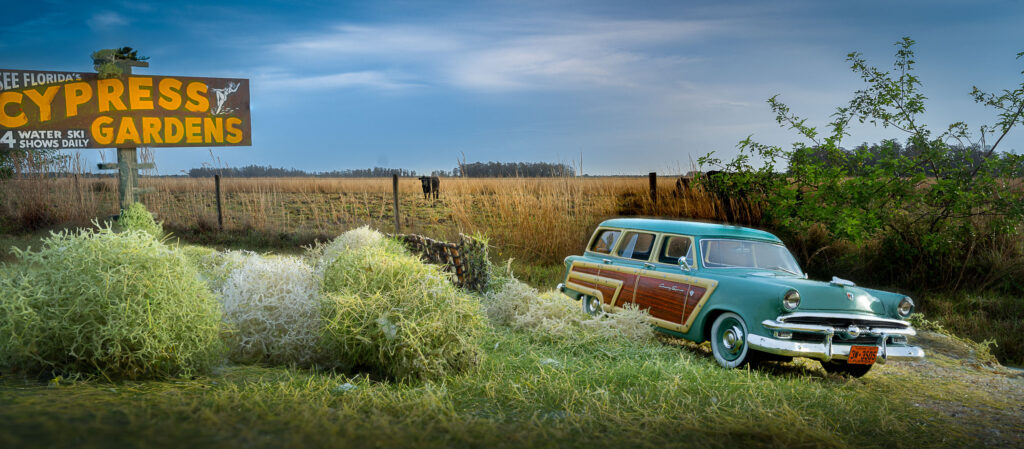
My images are created entirely “in-camera”. I set up a tripod and shoot a hand-built diorama carried to the location and balanced on a step ladder.
The camera’s wide-angle lens placed inches from the subject does the work to seamlessly weave together foreground and background. This technique, called forced perspective, is how early cinematographers made Godzilla and King Kong seem larger than life.
When I began the project, I wondered, “How much of Old Florida still exists?” I am a year in, and still discovering hidden gems all over the state.
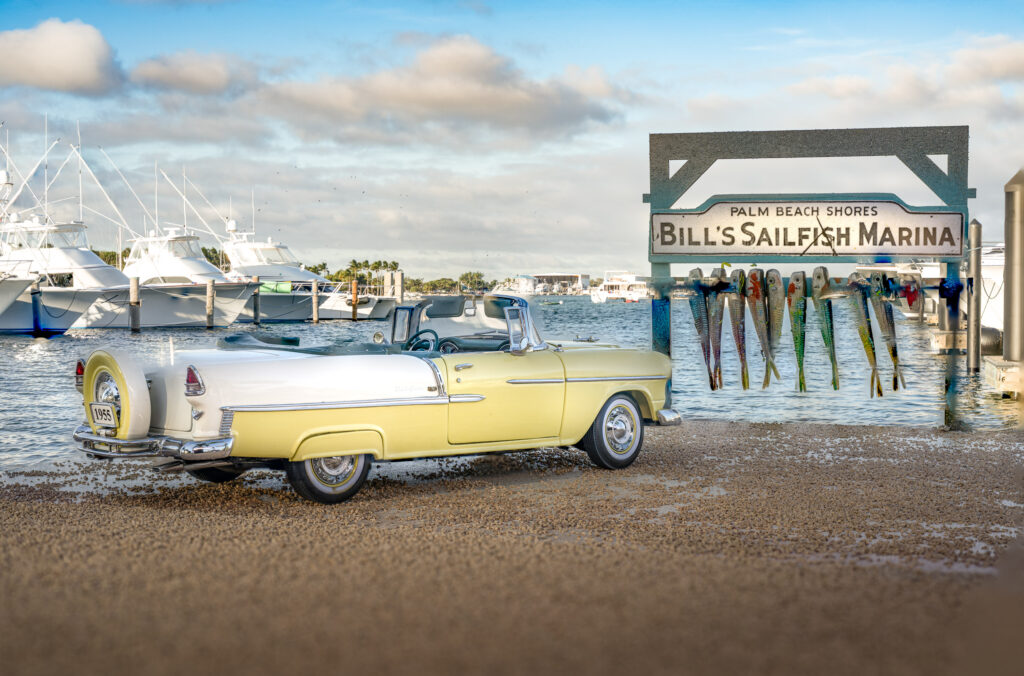
I am having a blast navigating across the peninsula to chase old Florida fruit stands, family run attractions, historic downtowns and untamed wilderness. I am also learning sad truths about the state’s history. So many of the beaches, parks, restaurants, hotels, attractions I photographed were segregated until the very end of the 1960’s. As a child, I was unaware, that if, my family were black, they would be turned away from all of these places, and any resistance would risk a run-in with a small town Florida Sheriff.
The natural environment of Florida at the time, was absolute wilderness broken only by farms. Since then, overwhelming population growth and development has changed most every horizon. Thankfully, by driving and exploring, the center of the state, one can still find sweeping panoramas of open lands and Cypress canopied rivers and springs. I am eager to capture and learn more about this dynamic period of change in Florida. My goal is to create an art exhibit that people will find enjoyable, not just for the camera trickery, or the nostalgic toy cars, but a small window into Florida’s past. Bob Gibson, July 2024.

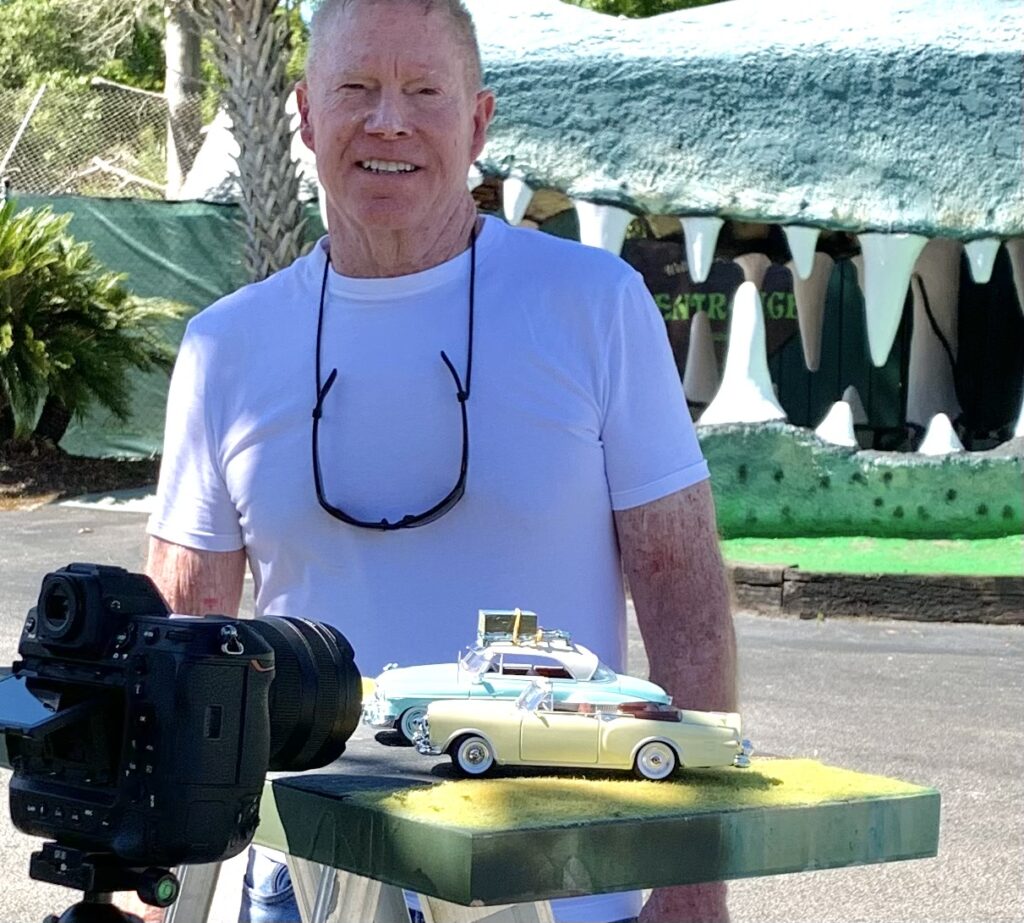
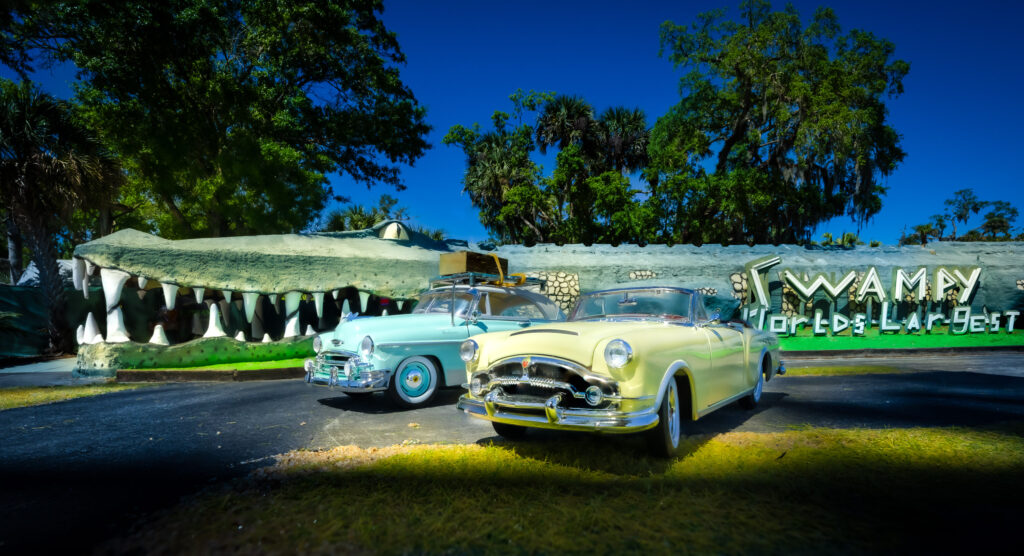
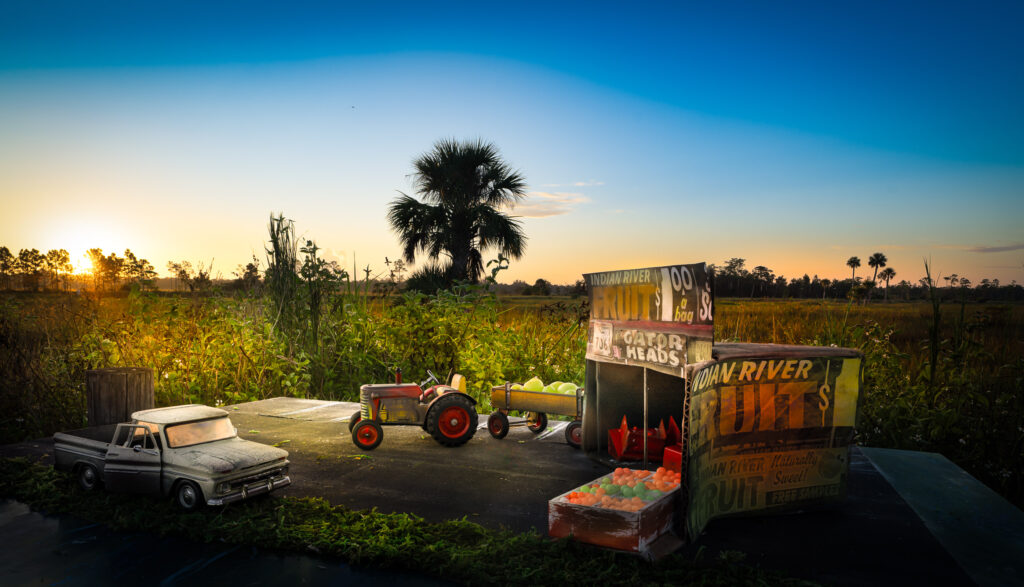
It grew to become a roadside stand selling fresh Indian River citrus, orange blossom perfume, boiled peanuts, fireworks and stuffed baby gators. The diorama is extremely primitive, a cardboard box, some pompano beads to look like oranges, arranged on an asphalt roof shingle and shot at sunrise in a grassy Florida marsh.
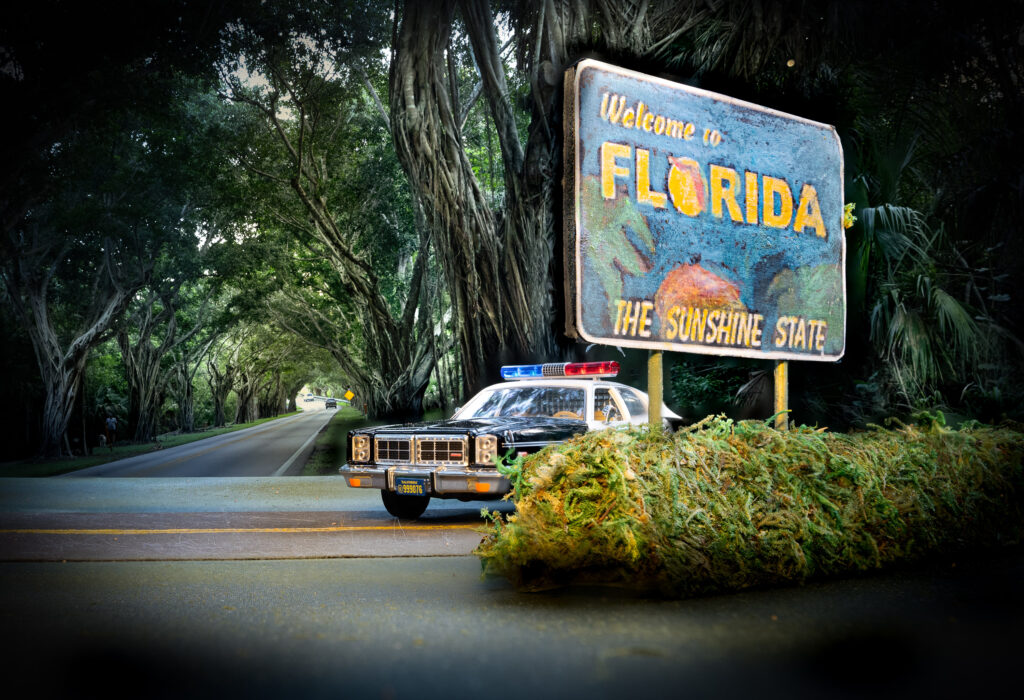
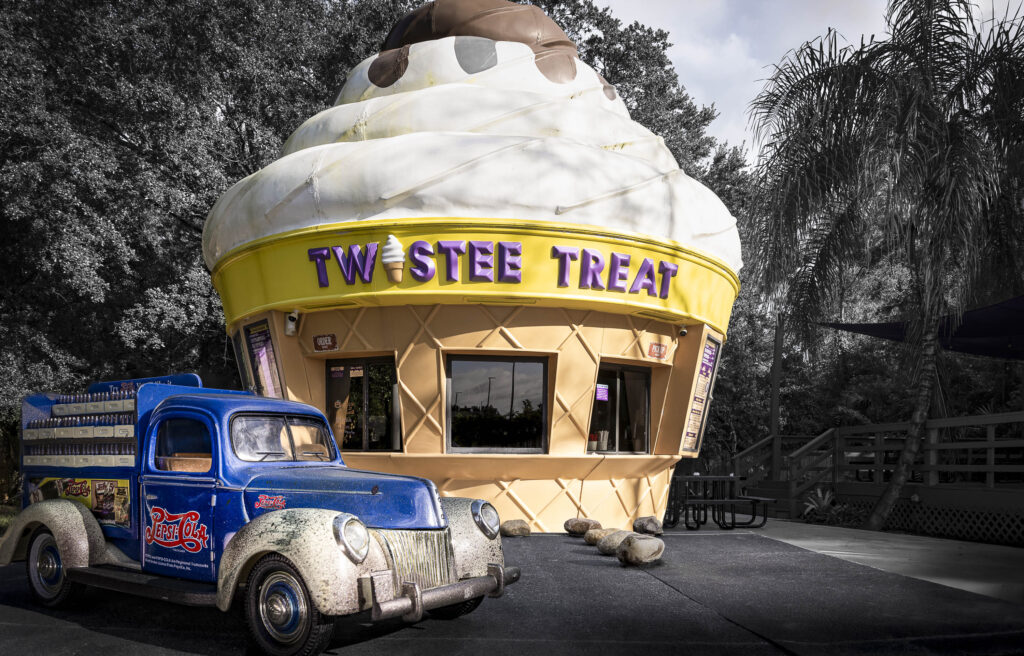
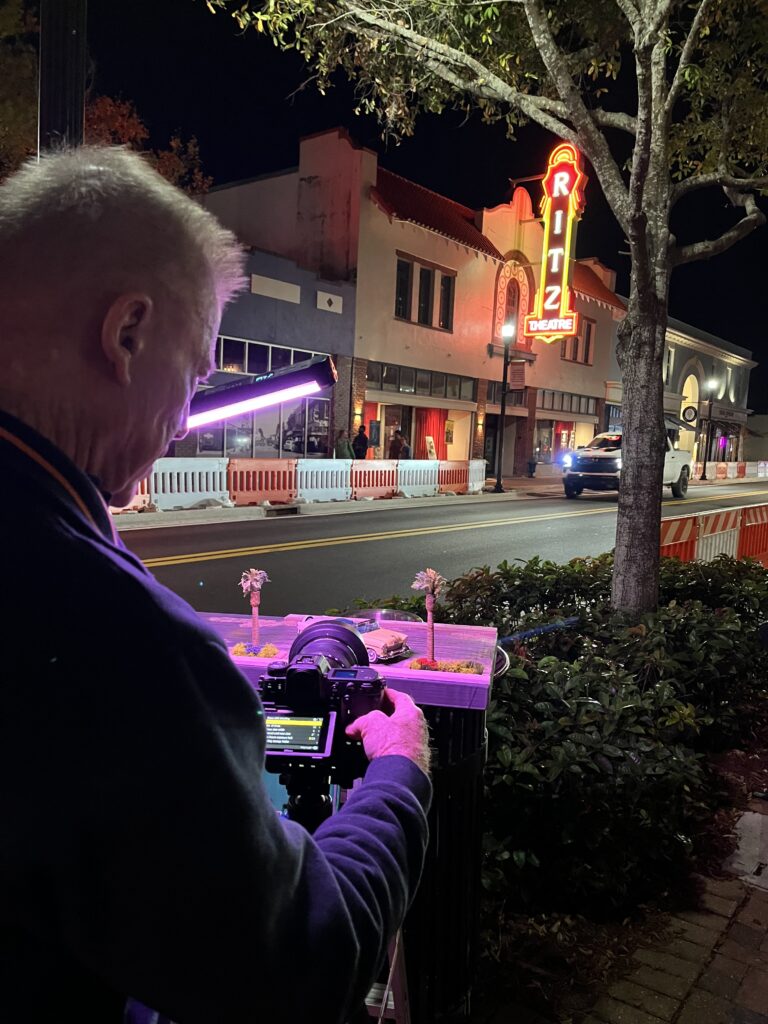
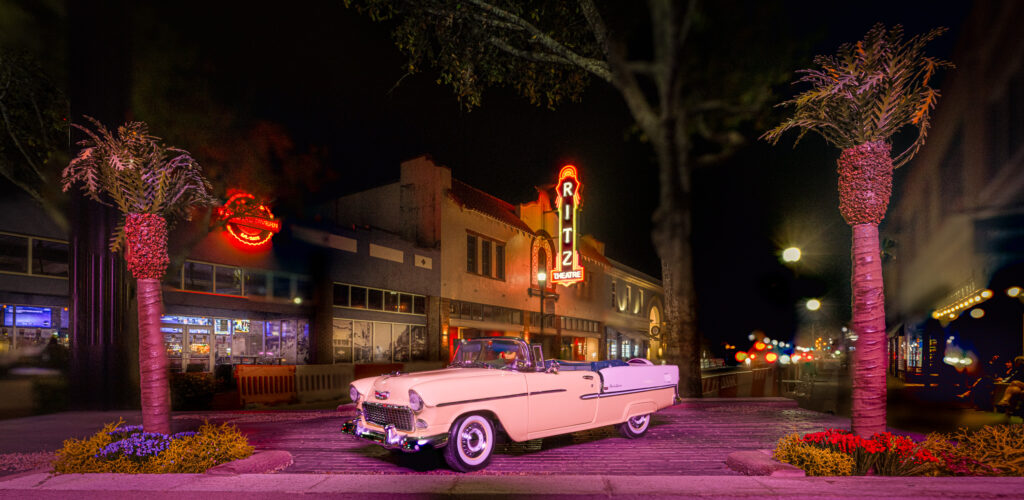
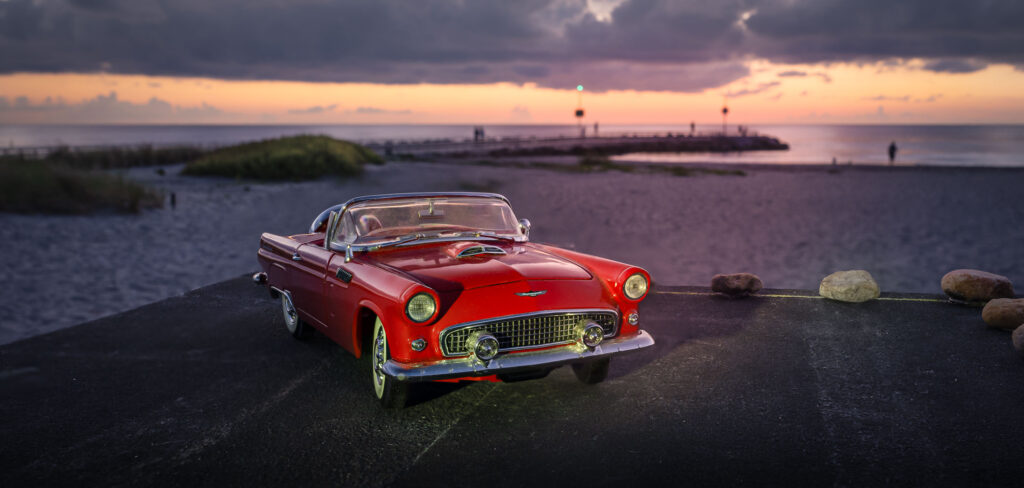
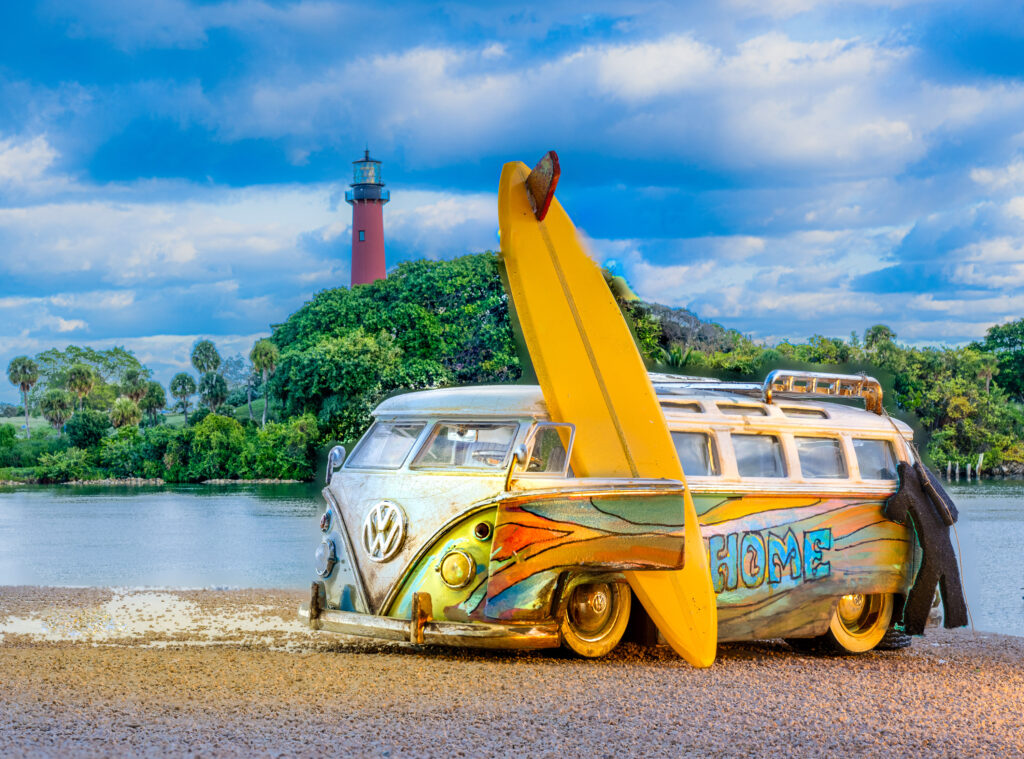
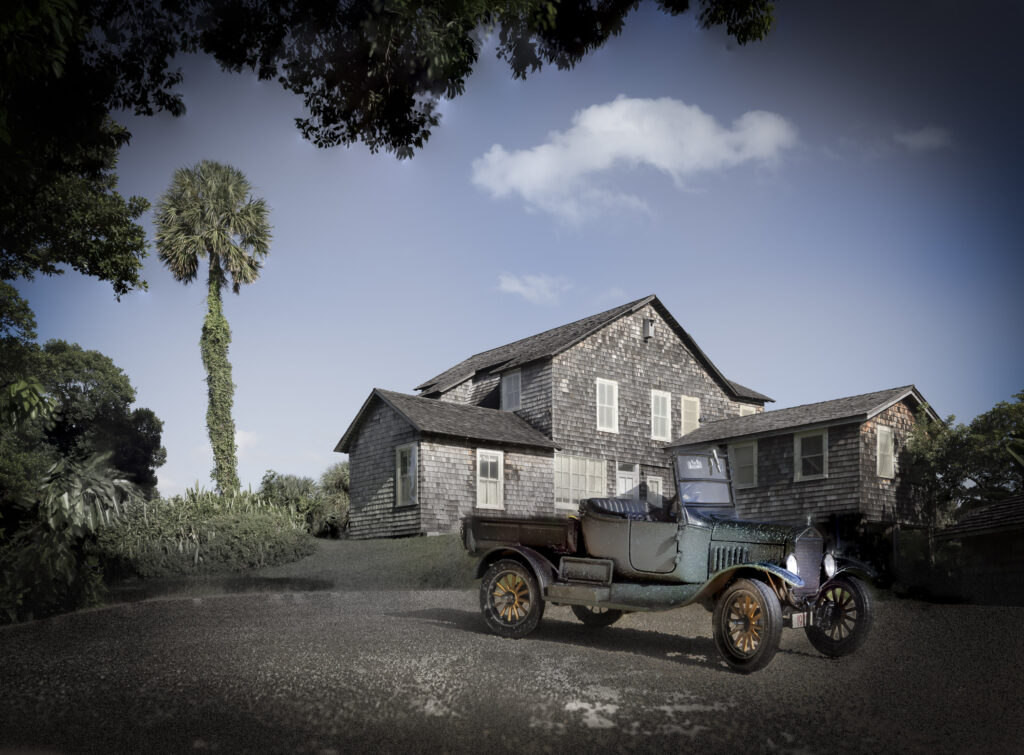
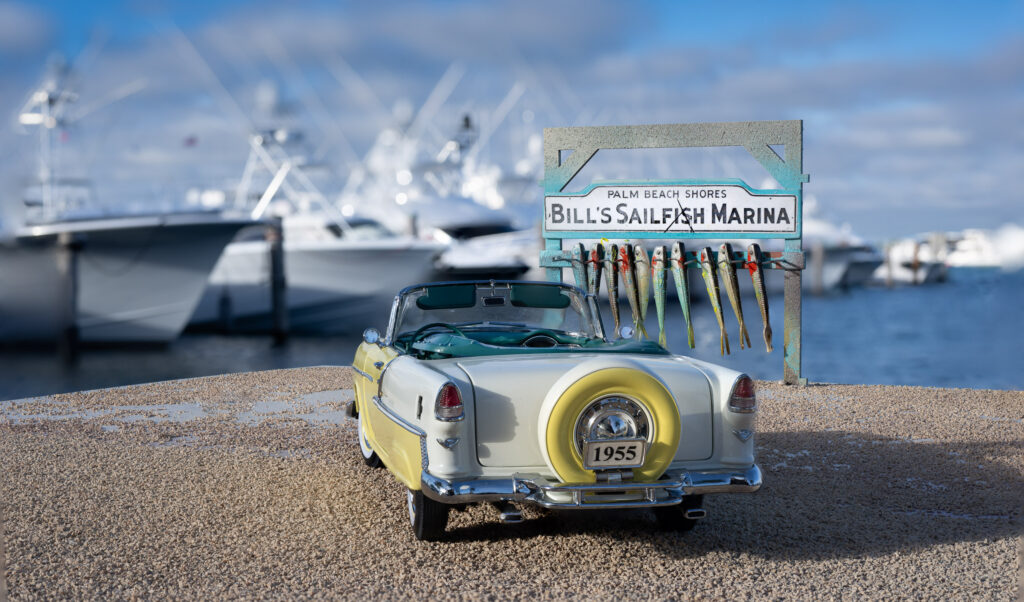
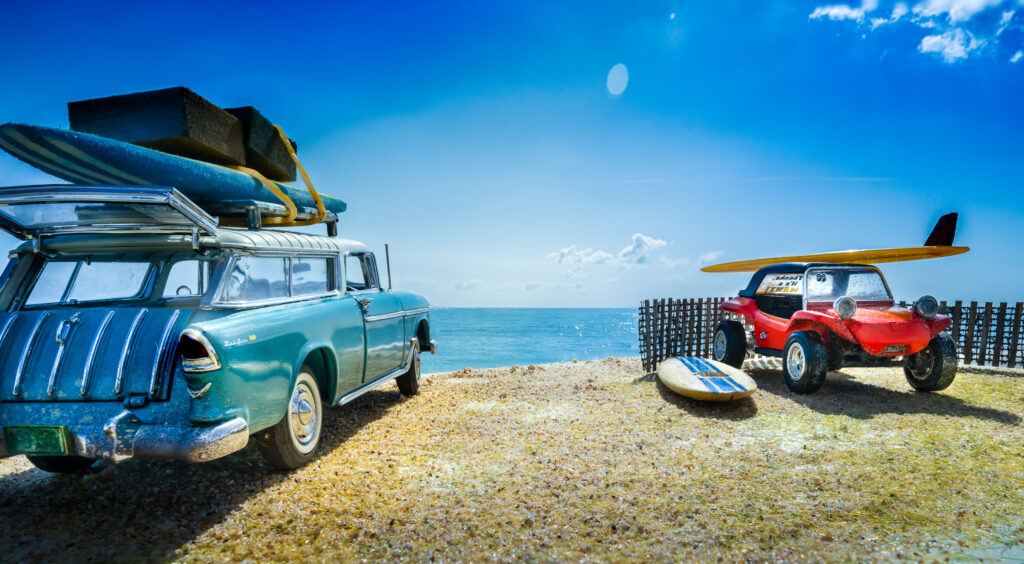
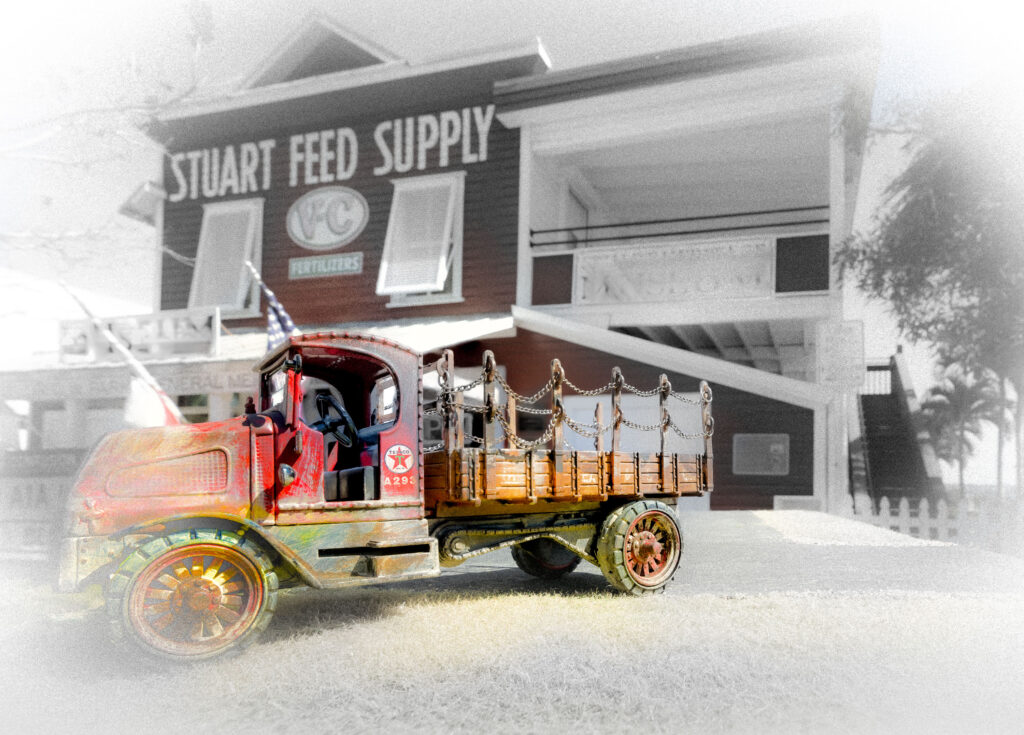
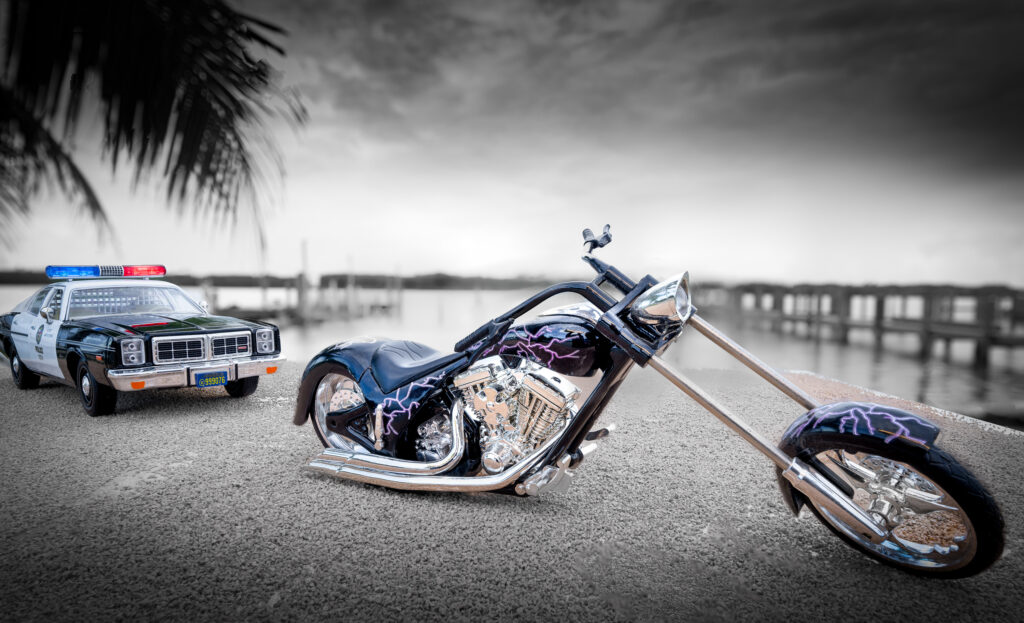
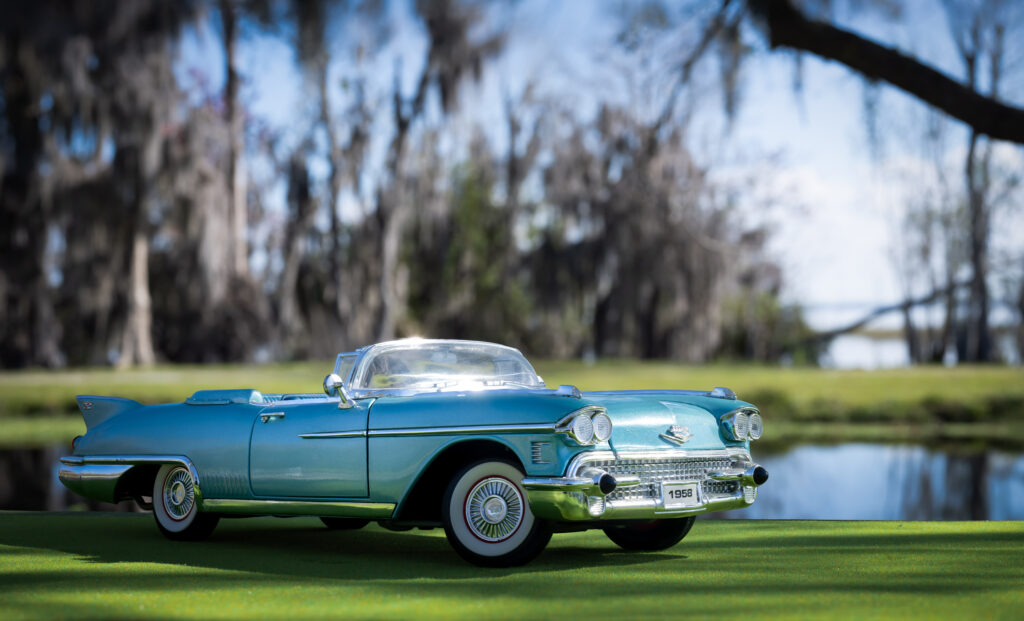
Blue Cypress Lake/
Spoonbill Junction
The headlights illuminate a hard packed gravel road throwing dust in every direction. The sky is pitched black and full of stars. There are no lights for hundreds of miles around. You slow down almost to a stop through with each patch of ground fog as you know canals chock full of XXL gators drops off each shoulder. Up ahead locals are floating their prized bass boat by lantern and car lights. You drive beyond into the darkness until The road ends. You have arrived at “Spoonbill Junction” a peninsula of shell rock. The stars fade. The pre-dawn “blue hour” reveals
Mangrove island rookery chock-full of Roseatte Spoonbills, Great Herons, Egrets.
The sun rises behind you, bathing the white and crimson birds in warm orange light. They fly gracefully just above their reflection in the glassy
River, directly toward the camera. Flaring their eight foot wing span they gently set down feet from your lens for easy close-ups. For this reason,
I call this secret spot, “Spoonbill Junction”.
After an unforgettable morning, you motor home. The car looks like a powdered donut, but you have trekked to a special place and witnessed the heart of wild Florida.
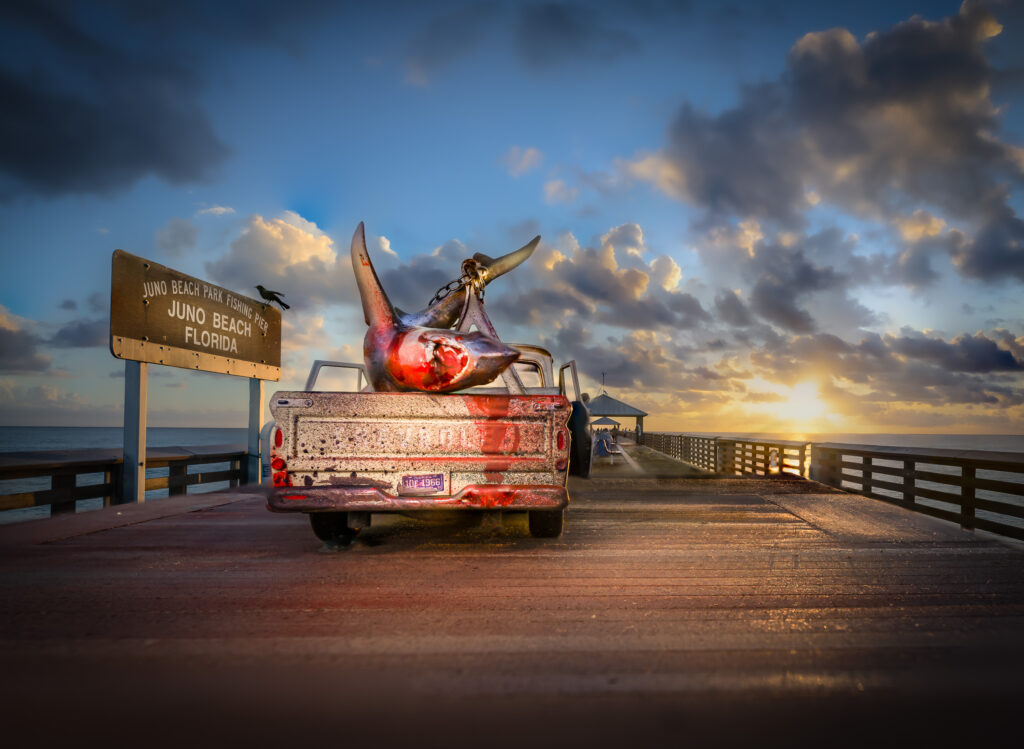
Sharks at Dawn, Juno Beach
During the months of June and July, the Atlantic Ocean near Juno Beach goes to sleep. Before the sun rises, its surface appears as a sheet of grey glass extending from the sand to the eastern horizon.
As the sun begins to rise, the glass is broken by fields of rippling baitfishes. From the end of the pier, fishermen and spectators take in a view that turns from serene to explosive flashes when a school of Bonita (small tuna like fishes) rushes in from the Gulf Stream.
Fishermen cry out “Boneys!” “Quick grab the poles!”
Suddenly the sound of screaming reels signal that every pole on the pier is connected to a 20 pound torpedo. The Bonita’s first run is its fastest and longest—straight out to sea for 200 yards, often a mere moment before the spool is empty and line breaks.
The Bonita’s second run is sideways, creating a havoc of crossed lines. And, then, just when fights are about to break out, A massive
Dorsal fin rises from the deep and speeds into the fray.
A grizzled veteran with a long pole curses, “I’ve got a shark”
All the crossed lines are forgotten and a communal drill goes into effect until a dozen teenagers snag the monster hammerhead with
Leaded hooks on boat line, fish is landed on the beach and carried to the back of a truck.
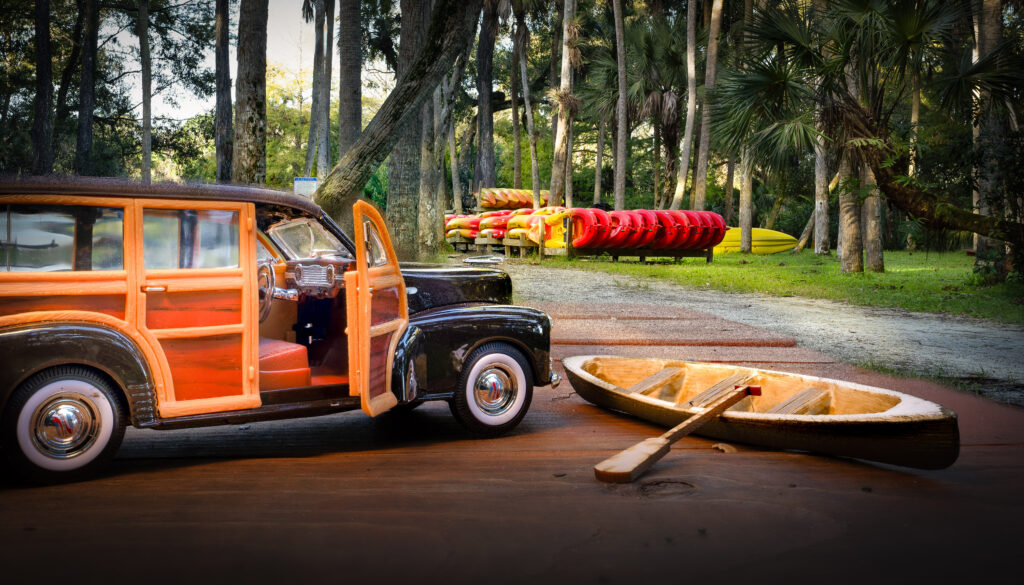
The Loxahatchee River on Florida’s Treasure Coast, begins as a Cypress Wetland watershed west of Jupiter,Florida and winds its way to the Atlantic Ocean. I often teach and photograph “bird photography”at Riverbend Preserve, a Palm Beach County Park that should be on everyone’s “Old Florida” bucket list. Here, one can walk or bicycle on family-friendly, hard gravel paths under the shaded canopy of century old oaks and enjoy face to face encounters with white-tailed deer, wood storks and the occasional Owl.
Some of my photos require planning and preparation. These shots were completely off-the-cuff. A early winter cold front had cleared and cooled the air. After a few hours of shooting Roseate Spoonbills and Herons from the parking lot, I reached into the trunk of the car, plucked out the miniature Woody Wagon and canoe , and placed them on a picnic table. With no tripod, and too lazy to return home ten minutes home to get one, I set the camera on top of a backpack and used the Nikon Z9’s auto focus stacking feature.
Somehow, exposure, focus and the forced perspective distances worked out and these required few Lightroom enhancements (just darkened and blurred the park bench to look more like a roadway) I pressed “save images”and posted them on Instagram like they were cell phone shots. A lucky lazy day!
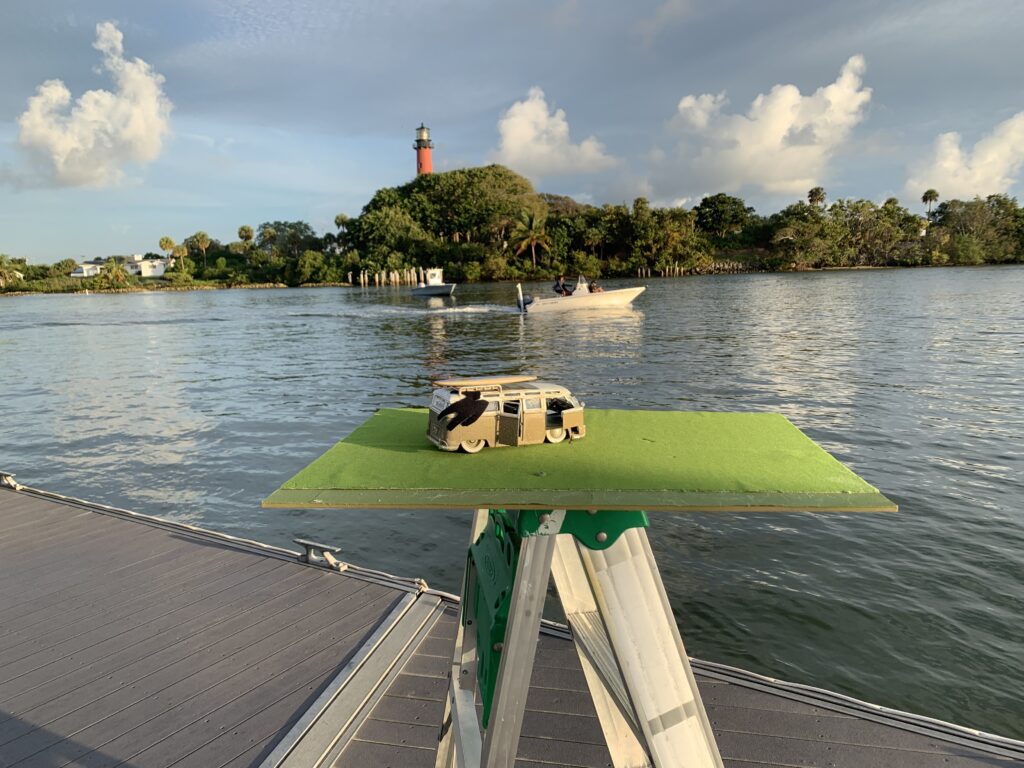
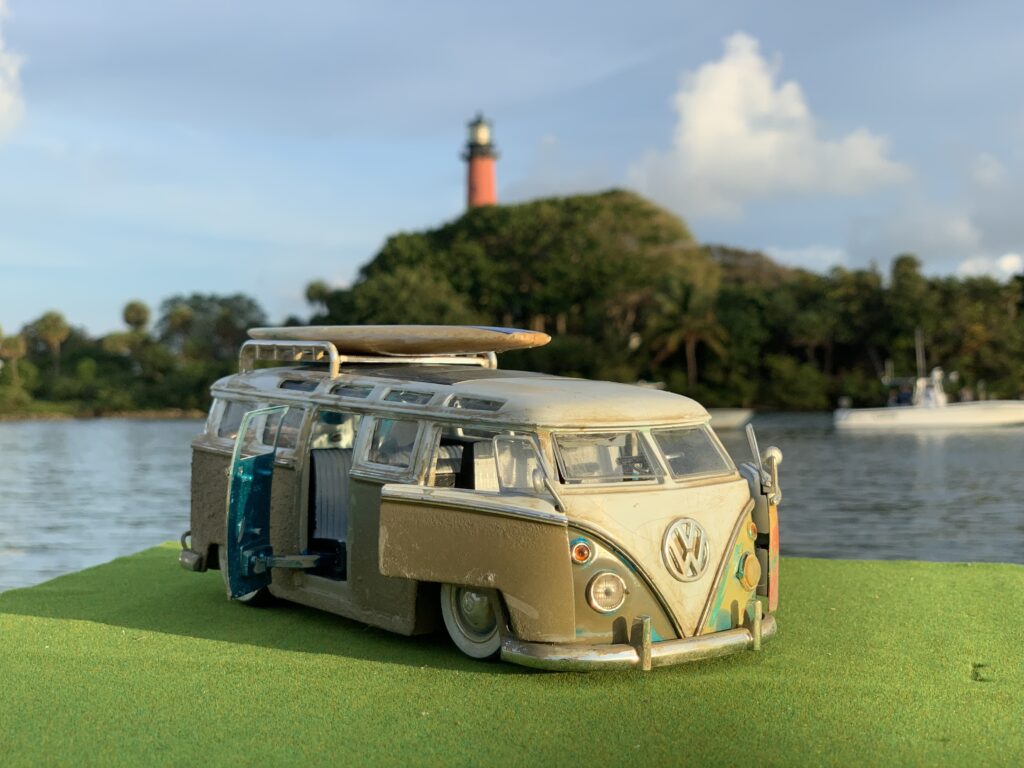

Hand painted signage, abundant between tiny coastal hamlets, propelled the Florida tourism boom of the 50’s and 60’s. Modern decades brought community sign codes to eliminate these wonderfully garage engineered masterpieces — so it brings a smile when one is lucky enough to drive a rural road, and come upon a clever example.
Making the miniature sign was as simple as pulling the hooks from a fishing lure and lathering it with super glue. Finding the red 1956 Ford Truck scale model made the shoot.
“Hooked on Live Bait”
Live Bait makes the difference between fishing and CATCHING. My Dad loved to fish with artificial lures. He loved the process of browsing for a new “magical” lure at Lott’s Tackle Shop near our home. The owner, George Lott was cut from the same cloth as my Dad–a depression era kid who learned to become an entrepreneur and earn a living by being clever and putting in twelve hour days. He and my Dad got along famously. Both never turned off their super salesmen personalities. “What are they biting on, George” my Dad would ask with a big smile knowing he had just opened his wallet to a real pro.
“Everything, said George Lott. “Especially the heavy Crocodile spoons in the surf. The fish hit them so hard, they break your line, so you need to have three or four!”
I did not share my Dad’s fishing strategy, and I did not have his wallet.
After school I learned to catch fish consistently with live bait. Just by laying on the concrete seawall and bending over the water, a kid could reach down and scoop up a handful of Sea Bugs. Hooked through the back, tossed right in, they drove the mangrove snapper crazy, and sometimes even a dinner plate sized Sheepshead. The lesson was clear, use the live bait that fish are feeding on!
So instead of paying for artificial lures with my lawn mowing money, I saved for a cast net and practiced throwing it over the back lawn until it landed in a perfect circle. My mother was worried I would lose a tooth by the common net throwing method, so George Lott showed me a special Non-teeth damaging casting method.
Next trip to the beach with my Dad, he caught a Bluefish on his first cast of the new Crockodile Spoon and was quite taken with himself while I struggled spinning and tossing a forty pound ball of net and lead weights. Just when the shoulders were about to give up, the net came in shining with flipping fish. I filled a deep pail of seawater with robust little Menhaden and hooked the largest through the hard part of its nose. At that point, just catching the bait, I had the best day of fishing ever. By now, I got to bait up my pole and throw. The cast arched over the incoming waves into a smooth area of sea–a deep spot unbroken by action–until the exact moment the Menhaden slapped the surface! Twenty minutes of fighting a huge fish, reveal a good eating Snook–so big that took two people to drag up the beach. Live bait became my Mantra. It’s the way to spot a local versus a visiting fisherman.
The local always has a Cast Net in hand, and a loop of line in his teeth.
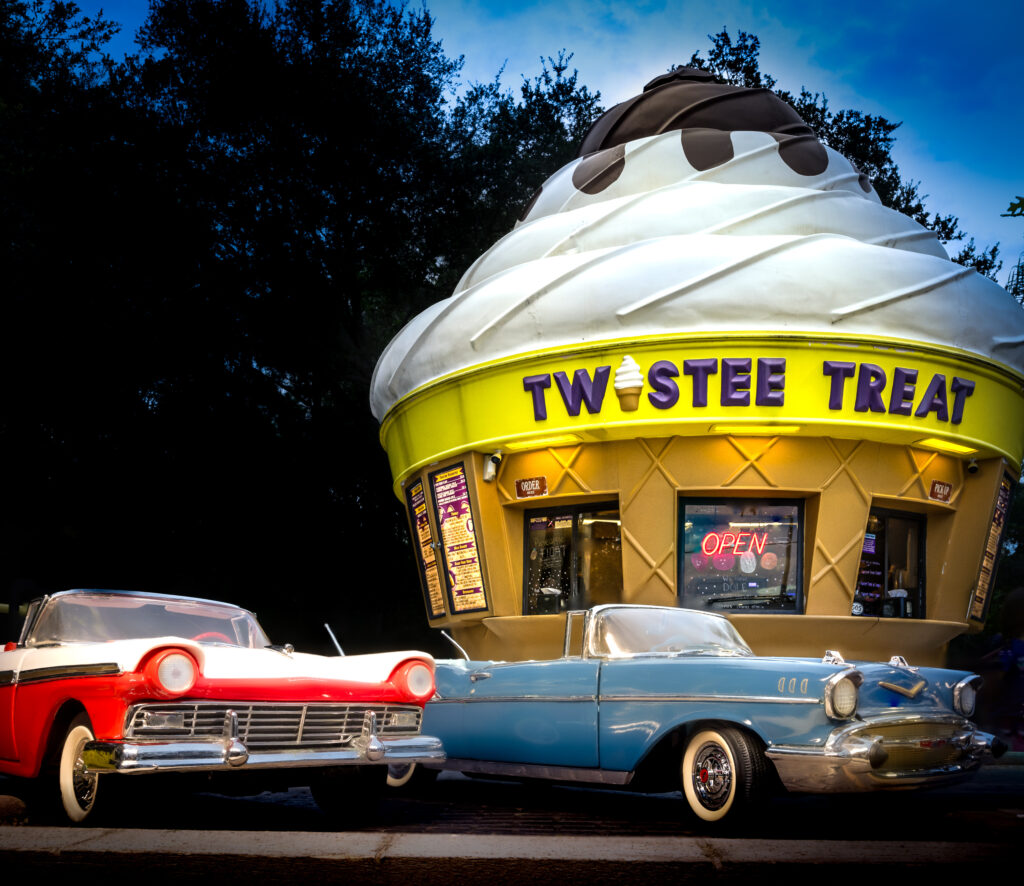
The end of WWII created a baby boom. By 1960, these “boomer” pre-teens were screaming for ice cream. Florida, the pioneer of pulling motorists off the road for retail sales, became the pioneer in what I call the field of “Ice Cream Architecture”. It started with Howard Johnson’s who put their 28 flavors of (increased butterfat) scoops under a fetching bright orange roof with a cupola and weathervane. The symbols grabbed kids and parents by the eyeballs with “miles ahead” signage countdowns, staged across the central Florida dairy country. Carvel is another great example.
Twistee Treat represents the pinnacle of Ice Cream architecture—the entire structure resides within the walls of a giant 25’ tall waffle cone of rich chocolate tipped vanilla soft serve.
The cone is the hero of this shot, and any extraneous foreground objects must support the mouth watering Vanilla topping. So easy and fun, was this challenge that I return on a regular basis.

This vintage Carvel Ice Cream stand in West Palm Beach Florida shot in the daytime did not do justice to the subject
until Adobe Lightroom came to the rescue to turn it into night.

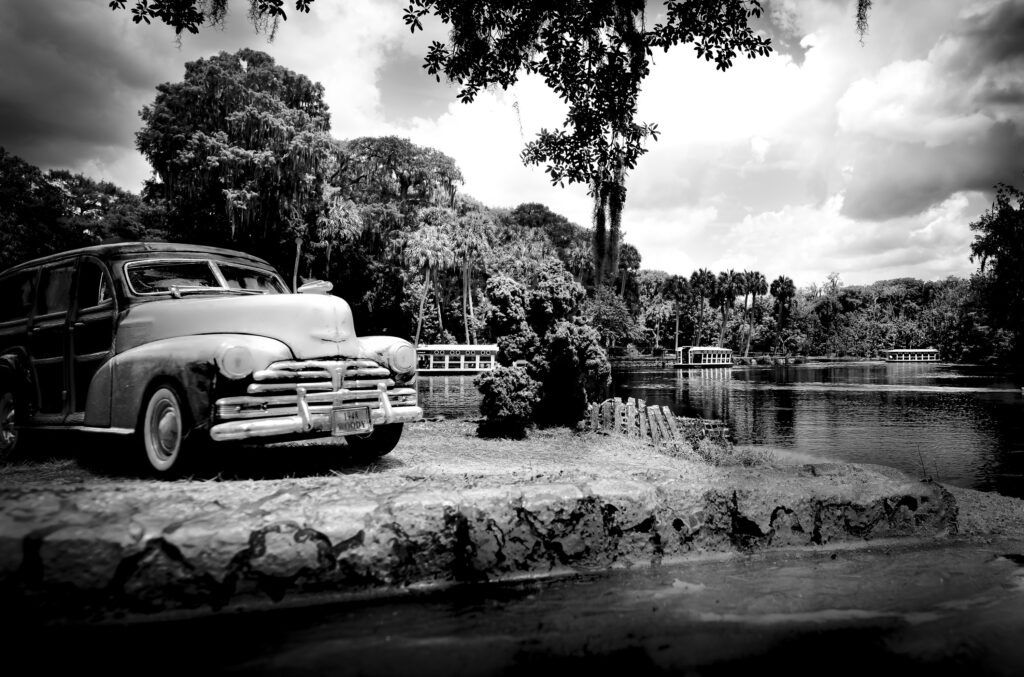
We arrived at Silver Springs, and towel changed in the parking lot and ran with excitement to the water.
Our South Florida ocean swims did not prepare us for the shock of frigid spring water.
We did the Australian Crawl like Johnny Weismuller. In the clear as a pool water, we saw giant freshwater fish schooling in the vibrant grass flats, then when the bottom dropped away to fifteen feet, we felt “suspended in air” directly over the —wondrous lapis azul spring vents surrounded by “silver” abalone bottom reflecting the sun in every direction.
Glass bottom boats plied the deeper Magnitude One vent and Silver River beyond the swimming area. A total of 30 springs, a history of Tarzan, Sea Hunt and Creature from the Black Lagoon, and a reptile show added to the wonder and mystery.
As I said at the beginning. This excercise began as an art project and became a history lesson.
Here is the sad truth of Florida’s history. The year was 1965, and it would be another four years before
Florida’s “greatest attraction” ceased to be restricted to “whites only”
Just outside the entrance, the Springs owners advertised “Paradise Park—for the exclusive enjoyment of colored folk”.
Decades later, this fact seems unbelievable. Imagine a black family attempting to vacation in Florida in the 1960’s. Most of the hotels, restaurants, public beaches and attractions were off-limits. Enforcement by local lawmen at the best included personal harrassment, at worst, often ibeatings, imprisionment and lynching. Like millions of white visitors at the time, my family didn’t notice or question. This haunts me to this day.

Cassadega Spiritualist Camp
In the early 70’s, I
drove (as a Halloween prank) with a carload of friends to attend a “message service” in nearby Cassadega Florida. The experience led me to return. “Mediums” and “Spritualists” (I’m not sure of the exact difference) tell people’s fortunes or communicate with their departed loved ones and do so for money. I won’t judge. I earned a living in advertising —an equally dubious career path.
I set up on the corner of the main drag under the shade of a magnificent Florida Oak and oriented the diorama to match the streetscape. Immediately, the book store owner who was also
A medium , spiritualist or both, came out to question my intent.
“Good afternoon,” he said, “May I ask what you are doing?”
I wanted to be respectful but couldn’t resist replying,
“I think you know already”
I then explain how I built the historically accurate sign and only with his permission would I continue setting up shot a picture.
As I worked and he watched, we became fast friends on this spirit plane. Just when things couldn’t get better, they did. A female medium, spiritualist or both stopped by to chat. She was draped with layers of transparent scarves that flowed in the breeze.
“Need help?” She asked.
“Yes!
“Walk toward me looking straight ahead like a ghost ( I caught myself from saying zombie)

opened in 1964 at the height of the Space Coast’s “moon fever”.
I spotted this “Old Florida gem” on the way to photograph a nighttime Space X launch (2024) on the wide waterway north of downtown Titusville .
I returned a month later to image the popular restaurant —soon after sunset, at the moment the neon lights turned on.
The fun of this shot was choosing the die cast cars—three iconic 60’s surf town rides—a Woody Wagon, a muscle car, and a hot rodded Chevy truck. I used a 14 to 24mm Nikon wide angle and placed the cars in the foreground until they obscured the modern cars that filled the drive-thru. For front to back focus, I shot and stacked 20 images. Speeding rush hour traffic of Hwy One made this a quick one.
Later in Adobe Lightroom, I combined the stacked “sunset image” of the restaurant with the “starry sky rocket trail” from the prior trip. (A little artistic license) Of, course after the shoot, I celebrated with a grilled “space dog”
“Ron the Nomad”
In 1969, surfboards shrank from nine feet to seven feet and shed thirty pounds of weight. They also transformed from bland colored logs into candy colored masterpieces of psychedelic artwork. The artist’s soul in my thirteen year old heart raced at the idea of custom making a surfboard.
Two local surfboard makers–Fox and Nomad competed. I was not inspired by the Fox boards. The Fox boards and their hotshot team riders surfed great. But, but in my opinion, the Nomad surfboards starting to show up around the beach, exhibited superior craftsmanship. Easily spotted from afar,
a Nomad surfboard boasted a bright glass-job with colors like grape, yellow, tangerine and cherry red.
Up close, the coloring’s transparent tint showed the sparkle of the shaped white foam blank beneath and the blonde wood balsa stringer. Best of all was the hippie influenced decal drawn by California artist Jim Ogden. Nomads looked like big pieces of candy! The man responsible for creating them was named Ron Heavyside.
With fifty dollars of saved lawn money, I asked my Mom to drive me to the Nomad factory in a Hypoluxo Industrial Park. At first we drove around and couldn’t find a sign. A parked dune buggy and some drums of Polyurethane resin were the only clue to the workshop. My Mom waited in the car and I opened a the which turned out to be a glassing room. It revealed a treasure trove of acid wash multi-colored colored boards drying on wall racks. The room was empty, so I follow the high pitched scream of a power planner coming from the adjacent bay. It took a bit all the courage I could muster, to open the door–I knew I was interrupting a job in progress.
In front of me stood a 6’3 giant with a blonde ball of hair extending an additional four inches. He wore a breathing mask like a WWI trench warfare soldier and when he pulled it down, he gave me the ten thousand yard stare, “What?” he asked impatiently.
In a long nervous run-on introduction, I begged him to sell me a blank and some fiberglass cloth.
“I love your boards, and I have cash”
“Then go to my shop on the beach and buy one”
“I have sixty dollars of lawn mowing money. I came from all the way from North Palm Beach.
North Palm Beach, holy shit, how did you find this place, he said sarcastically.
“My mom drove”
He stared at me for a moment and then softened.
“Alright, alright, just this once”
Ron Heavyside took the end of a compressed air hose and sprayed the layer of snow-like foam dust from his head, shoulders and arms. ..I’ve got boards to shape all day. I don’t have time for this shit”
I quickly scanned the room. On the wall was hung templates and calipers.
Well?
I pointed to a double page color spread of Hawaiian surfer. That’s Lesley Potts at Honolua Bay.
“Look kid, You are gonna need a blank, four yards of six ounce and two gallons of resin and a inbox.
I don’t have an extra fin to sell you, get one somewhere else.”
We stepped outside and he filled my empty milk jugs with resin.
My Mom leaned out the car window, waved to him and said “thank you, sir!”
“I also need some orange transparent pigment.”
He shook his head. “Then you promise to never come back?”
My first business success began that day thanks to Ron Heavyside.
Over the next five years, I returned every two months and each time, Ron shook his head, sighed and said,
“Ok show me your latest board.”
He would then looked it over and offer a tip on shaping, glassing, sanding or hot coating.
My Mom would wave from the car and yell, “Thank you again”.
He has passed now, but his success lives on in his children that operate his retail store
in Briney Breezes. If Ron were here today, I would thank him for the patience and consideration he gave me. What a person of great talent and character!


This is my recreation of the Nomad “Factory” in Hypoluxo, Florida circa 1968.
